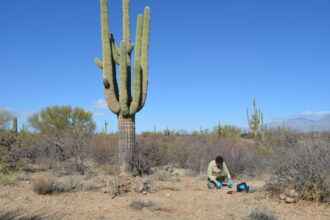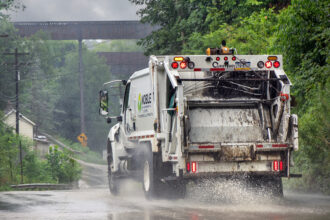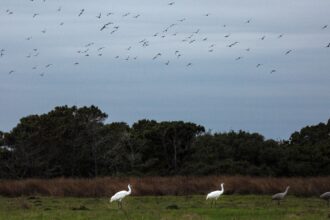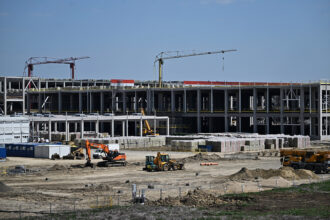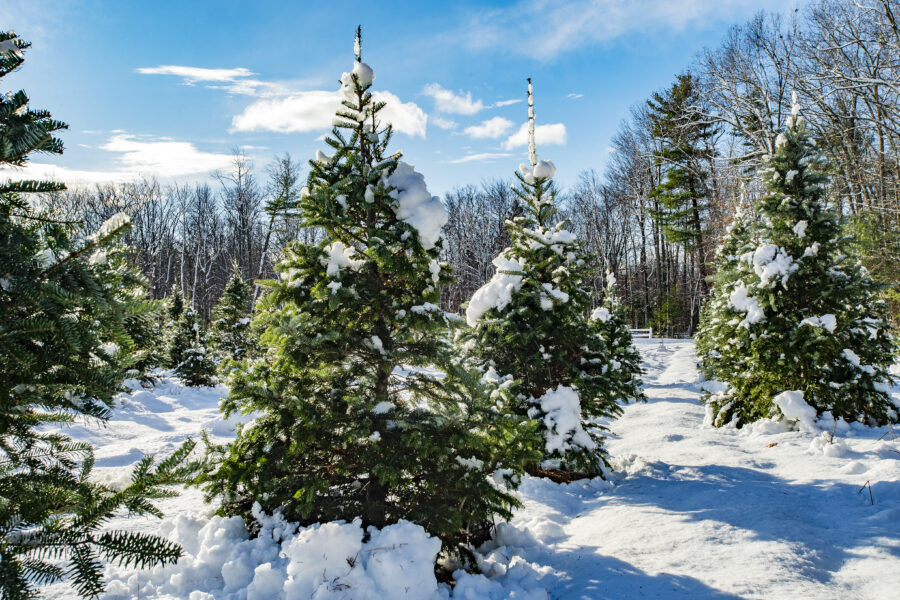When the remnants of a deadly typhoon slammed Western Alaska’s Yukon-Kuskokwim Delta a week and a half ago, it brought hurricane-force winds and catastrophic flooding to the remote area.
More than 1,500 people were evacuated from small villages scattered across this part of the Alaskan tundra, an extremely difficult process in an area only reachable by plane, boat or snowmobile at this time of year. At least one person was killed, and two more are missing.
Fueling the largest storm surge on record in the delta, the tail of Typhoon Halong left its mark on a region already beset by sea-level rise, permafrost melt and coastal erosion exacerbated by climate change. Entire villages were razed, critical infrastructure like schools and powerlines were decimated and food supplies that locals spent months hunting and gathering ahead of the winter were lost.
As displaced survivors reel in the wake of the destruction, they face a question that so many must in an era of worsening climate disasters: Return and rebuild or relocate altogether?
What Happened? Starting as a powerful typhoon east of Japan, Halong was carried northeastward by the jet stream into the Bering Sea, just as early forecasts had predicted last week. But things took a turn when the storm neared Alaska.
Unseasonably warm waters over the far North Pacific supercharged the weakened storm as it shifted course between Saint Lawrence Island and the Yukon-Kuskokwim Delta, a low-lying tundra a bit bigger than Washington state. The changes were not shown on forecasts until less than two days before the storm crossed into Alaskan waters, leaving little time to evacuate, Rick Thoman, a climate specialist at the University of Alaska Fairbanks, told me.
On Oct. 11 and 12, the storm caused “extreme, catastrophic flooding in the [delta], whereas places that we had been concerned about just a few days before, places like Nome, had no appreciable flooding at all,” he said. As the rain and sea swept up entire homes, residents sought shelter wherever they could, including in schools without working toilets, CBS News reports.
The coastal villages of Kipnuk and Kwigillingok were the hardest hit, with Kipnuk seeing a storm surge 6.6 feet higher than the typical daily high tide, nearly two feet above the previous record, according to Yale Climate Connections. At a press conference last Monday, Capt. Christopher Culpepper, the U.S. Coast Guard commander for Western Alaska, recounted the destruction.
“Several of these villages have been completely devastated, absolutely flooded, several feet deep,” he said. “This took homes off of foundations. This took people into peril, where folks were swimming, floating, trying to find debris to hold onto in the cover of darkness.”
With villages in shambles, the U.S. Coast Guard rushed to bring supplies and evacuate survivors by air in the days following the worst of the storm. More than 2,000 evacuees remain displaced in other towns and cities, such as Anchorage and Bethel, and likely won’t be able to return to their villages for at least 18 months, Alaska Gov. Mike Dunleavy said Friday.
Some experts say that Trump administration cuts contributed to flawed forecasts and the lack of preparedness ahead of the storm, CNN reports. Earlier this year, the administration downsized weather balloon coverage, including in Western Alaska. These tools measure wind speed and direction, air temperature, humidity and other factors that can help inform weather predictions.
I reached out to the National Weather Service about that but did not hear back.
Separately, the U.S. Environmental Protection Agency canceled a $20 million flood protection grant for Kipnuk in May, The New York Times reports. Construction under this grant would not have begun until 2026.
“The environmental justice funding cancelled by EPA would not have prevented or safeguarded the community from the mass destruction and tragedy caused by such a large and devastating typhoon of this magnitude,” an EPA spokesperson told Inside Climate News over email. “While there are some on the left who would prefer to have seen those tax dollars washed away, the EPA now has the resources available to ensure the money is spent appropriately and wisely, including over $140 million this Administration has provided to the Denali Commission and the State of Alaska.”
President Donald Trump has yet to declare a national emergency in the wake of this storm, despite requests from Dunleavy, other Alaska politicians and the Alaska Federation of Natives, the state’s largest Indigenous organization. Though Vice President JD Vance said in a Friday post on X that he and Trump are “working closely with” the governor and U.S. Sen. Dan Sullivan of Alaska to get residents “the help you need,” not declaring a disaster blocks people in the state from receiving certain federal funds to support evacuation and recovery, according to Samantha Montano, an associate professor of emergency management at Massachusetts Maritime Academy.
“For an event of this size, that is extremely unusual. It should have been signed the day of or day after the governor requested,” she told me.
Asked for comment, a White House official said in an email that the Trump administration “has already been supporting the State of Alaska with search and rescue, damage assessments, environmental response, and other assistance in support of evacuation, emergency sheltering, and mass care.”
“The State of Alaska has mounted an immediate and aggressive response using their own resources to execute the largest mass evacuation in the state’s history,” the official said. “To supplement their response, the governor has requested an expedited major disaster declaration to which the President is reviewing.”
Recipe for Disaster: The Indigenous peoples of the Yukon-Kuskokwim Delta live hundreds of miles from the U.S. road system. Though these groups are no strangers to harsh weather, living so far off the grid can add layers of complexity to disaster response and recovery.
While many people in more populated regions like the Northeastern U.S. can drive to other areas and stay in hotels or shelters during a storm, such as the recent Nor’easter that flooded the East Coast, residents of Kipnuk and Kwigillingok don’t have that option, Thoman said.
“Remote in Alaska does not mean the same as remote in Montana,” he said. “Communications in that part of Southwest Alaska are very poor. Internet connectivity is unreliable and intermittent. They don’t even get good radio reception.”
Had there been a more accurate forecast leading up to the storm, he said, it would still have been hard to reach the most affected people.
Language and cultural barriers can also be a complicating factor, as most people’s first language in Kipnuk is traditional Yup’ik. That’s why it’s so valuable to have emergency responders who speak the language of affected people, Montano said. She pointed to Pvt. Alan Borbridge of the Alaska Army National Guard, who spoke Yup’ik to evacuees displaced in Bethel after the floods, as the Anchorage Daily News reported.
“In emergency management, anytime that you can have people responding who have shared experiences with the people who are being impacted by the disaster, it can lead to a more effective response,” Montano said. ”I think it is really important in terms of building trust between responders and survivors.”
But this is only a small piece of home for evacuees who are struggling to adapt to the louder and more populous cities they’re staying in, as their actual homes lie in ruins hundreds of miles away.
“When we talk about recovery, we very often are talking about the physical recovery—rebuilding houses and roads and whatnot,” Montano said. “But the psychological recovery from disasters is just as important and in many ways much, much more complicated.”
Some survivors are committed to rebuilding and maintaining their traditions in the place where their peoples have resided for millennia. Others have questioned if returning to the delta is realistic as climate-fueled weather worsens and their low-lying homes are exposed to widespread flooding.
“We’re not going to be well. Storms are going to get worse, and it’s not going to be livable,” Mike Williams Sr., a tribal leader from the Kuskokwim River village of Akiak, told the Alaska Beacon. “We’re past the tipping point, maybe.”
Recovery itself will be much harder in this region than in other parts of the U.S. Temperatures in Western Alaska are already dipping below freezing, which means some flooded areas likely won’t dry out fully until conditions warm up in the spring, Thoman said. And as difficult as it was to get people out of the area, it will be even tougher to get contractors and large construction materials in to repair and build critical infrastructure.
“Just putting up houses where they were and doing nothing else to protect them is just a recipe for another disaster,” he said. In any case, though, Thoman stressed that tribal leaders must play a central role in decision-making.
“The governor of Alaska had a big press conference the other day, and there were no tribal leaders on the stage,” he said. “That was not a good thing, in my view, because the tribes need to be at the front and center of what happens in these communities going forward.”
More Top Climate News
Mosquitoes were found in Iceland for the first time, likely due to warming in the region, Helena Horton reports for The Guardian. Similar to Antarctica, frigid temperatures have made Iceland inhospitable for the insect. However, Iceland is warming four times as fast as the rest of the Northern Hemisphere, and its wetlands are seemingly more conducive to mosquito breeding. A citizen scientist was the first to spot the blood-sucking creatures, but an entomologist at the Natural Science Institute of Iceland confirmed them.
Members of the International Maritime Organization voted to postpone climate regulations on the shipping industry—including the world’s first global carbon fee on shipping—after President Donald Trump threatened trade sanctions on countries that were in support of the move, Sibi Arasu and Jennifer McDermott report for The Associated Press. U.S. Secretary of State Marco Rubio praised the outcome as a “win” for Trump and the country. But others say it could derail progress on curbing shipping emissions, a large contributor to the global warming that is killing people and destroying property around the world.
In (slightly) good news: Endangered North Atlantic right whale populations increased a bit last year, according to the latest data. Scientists estimate there were 384 individuals—eight whales more than the year prior. This improvement is largely due to conservation efforts, including fishing closures and boat speed limits to prevent entanglements and vessel collisions, according to the New England Aquarium’s Anderson Cabot Center for Ocean Life. However, conservation groups say these numbers still aren’t high enough to sustain healthy populations.
“An increase in the North Atlantic right whale population is an encouraging sign that recovery is possible, but we are not out of danger yet,” Hanna Vatcher, a campaigner at the nonprofit Oceana Canada, said in a statement.
Postcard From … California

For this installment of “Postcards From,” Today’s Climate reader Joan Linney, who lives in Sonoma County, California, sent a photo of a scorched chaparral forest in California. It was taken several months after the Glass Fire of 2020, “after the spring rains had germinated grass seed waiting under the heavy brush for a chance to sprout,” she said over email.
“We lost our home and community in that fire, but to me, the pic shows the resilience of nature,” she said.
A special shoutout to Joan for sharing such a sensitive moment from her time in nature. Today’s Climate readers, thank you for sending in your own photos, whether they are from a walk in the park or a time when climate impacts hit home. Please send in your nature photos for us to feature in our “Postcards From” section. Email them to [email protected].
This piece was updated Oct. 22, 2025, with new details from the White House about its response to the Alaska flooding.
About This Story
Perhaps you noticed: This story, like all the news we publish, is free to read. That’s because Inside Climate News is a 501c3 nonprofit organization. We do not charge a subscription fee, lock our news behind a paywall, or clutter our website with ads. We make our news on climate and the environment freely available to you and anyone who wants it.
That’s not all. We also share our news for free with scores of other media organizations around the country. Many of them can’t afford to do environmental journalism of their own. We’ve built bureaus from coast to coast to report local stories, collaborate with local newsrooms and co-publish articles so that this vital work is shared as widely as possible.
Two of us launched ICN in 2007. Six years later we earned a Pulitzer Prize for National Reporting, and now we run the oldest and largest dedicated climate newsroom in the nation. We tell the story in all its complexity. We hold polluters accountable. We expose environmental injustice. We debunk misinformation. We scrutinize solutions and inspire action.
Donations from readers like you fund every aspect of what we do. If you don’t already, will you support our ongoing work, our reporting on the biggest crisis facing our planet, and help us reach even more readers in more places?
Please take a moment to make a tax-deductible donation. Every one of them makes a difference.
Thank you,









